![]()
![]()
![]()
Use LEFT and RIGHT arrow keys to navigate between flashcards;
Use UP and DOWN arrow keys to flip the card;
H to show hint;
A reads text to speech;
29 Cards in this Set
- Front
- Back
|
Amino acids generally have ____ center except for _____.
They are commonly found in their ____ form. |
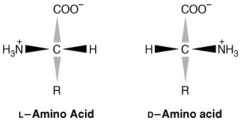
A Chiral center
Glycine L-amino acid form (amino on left) is more commonly found in nature. D-acids maybe found. |
|
|
Proline
|

Differs from other amino acids. Has a secondary amino group and forms rigid ring structure.
Bonds with proline lead to bends in protein shape and interrupts alpha-helix. Collagen is rich in proline. |
|
|
Nonpolar, aliphatic side chain AA's:
|
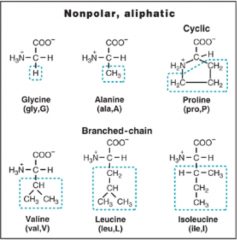
Aliphatic -do not contain rings
Alanine (A), Glycine (G) and Proline (P) - cyclic, Branched: Valine (V), Leucine (L) and Isoleucine (I) |
|
|
Aromatic Side Chains:
|
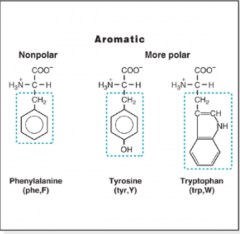
Phenylalanine (F) - Non-Polar
Tryptophan (W) - Slight Polar Tyrosine (Y) - Polar - Has O - more water interaction |
|
|
Sulfur-containg AA's:
|
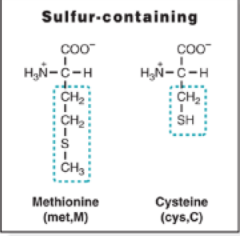
Methionie (M) and
Cysteine (C): -constains sulfhydryl groups, 2 cysteine can be used to form disulfide bond. -uncharged and polar at neutral pH |
|
|
What is responsible for UV light absorbance?
|
Aromaticity and Trp is primary with absorbance at 280 nm that is 4x higher than Tyr.
F does not show much absorbance |
|
|
Polar, uncharged AA
|
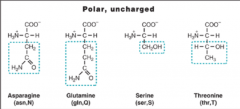
Serine (Ser)
Threonine (Thr) Cysteine (Cys) Asparagine (Asn) Glutamine (Gln) |
|
|
Charged AA
|

Acidic - a-AA carboxyl group is negatively charged (pk ~4)
Aspartic Acid (Asp) Glutamic Acid (Glu) Negative will want to go to water - act polar. Basic - amino group of apha-AA positively charged at physiological pH. (pk >10) Lysine (Lys) Arginine (Arg) Histidine (His) |
|
|
Alanine
|
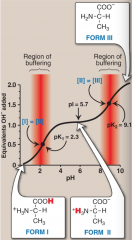
Is non-polar, aliphatic.
Has two ionizable groups giving 2 pka that gives two buffering regions. Can act as either a base or an acid. Most AA are not suitable as physiological pH, to high or low |
|
|
Histidine
|
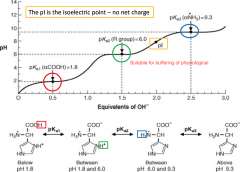
Is a basic positively charged AA.
Histidine chain has imidazole ring (pka 6) which allows buffering of a possible drop in pH. -Hemoglobin is rich in histidine. |
|
|
How are biological active amines formed?
|
a-AA are precursors for active amines. Amino group is retained and a-carboxyl group is removed as CO2(decarboxylated)
|
|
|
GABA
|
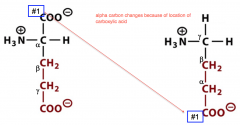
gamma-aminobutyric acid, formed by decarboxylation of a-carboxyl group of glutamate
|
|
|
Histamine
|
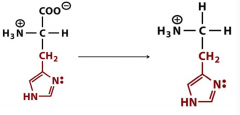
Formed by decarboxylation of histidine.
|
|
|
How is serotonin made?
|
Serotonin is made from Tryptophan which is first hydroxylated to 5-hydroxytryptophan and then decarboxylated.
Serotonin is important in pain perception and regulation of sleep, temperature and blood pressure. |
|
|
Prozac
|
Is an antidepressant drug that blocks serotonin elimination from synaptic clef. Inhibits the re-uptake of serotonin enhancing action of neurotransmitter.
|
|
|
Catecholamines
|
Include dopamine, norepinephrine and epinephrine.
Which are formed from tyrosine. Dopamine and norepinephrine are mainly neurotransmitters. Epi and Norepi may act as hormones. |
|
|
Dopamine
|

Acts as neurotransmitter, or can be used as intermediate for synthesis of norepinephrine or epinephrine.
Tryosine is first hydroxylated to dihydroxy-phenylalanine (L-DOPA) ---> decarboxylated to dopamine (first catecholamine). |
|
|
Important of R groups of proteins
|
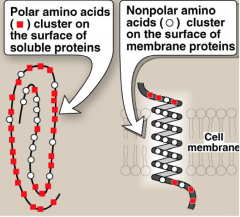
Determine how a protein will fold based on charged and polarity. Polar AA cluster on surface of soluble proteins and non-polar cluster on surface of membrane proteins.
|
|
|
What determine the 3-D structure of protein?
|
The amino acid sequence( primary structure) will determine the 3-D.
Covalent bonds art the strongest. Non-covalent bonds are weaker: H bonds are weaker Ionic bonds can be strong VDW (london) bonds are the weakest |
|
|
Bonding of secondary structures?
|
Are stabilized by hydrogen bonds, involving atoms of peptide bonds. C=O and N-H binding.
Beta sheets or a-helix -3.6 residues per turn -H bonds are perpendicular (parallel to axis) -R groups are direct outside of helix |
|
|
What cause interruption of a-helix?
|
Electrostatic repulsion or attraction of AA with charged R-groups. Bulkiness of R-groups and helix disruption by proline and glycine residues.
|
|
|
What holds the A and B chains of insulin together?
|
Held by covalent inter-chain disulfide bonds. Bond folds the hormone which is needed for receptor recognition.
C-peptide is needed for proper formation of this bind. Later cleaved and released from insulin into blood. |
|
|
Chaperone function and HsP60
|
Facilitate proper folding - knowing as heat shock proteins (HsP). Hsp60 have barrel shape and required for correct folding of cellular proteins, used to aid folding protein after crossing cellular membrane.
|
|
|
How to break hydrogen bonds?
|
Heat and 5-10M urea and salt
|
|
|
How to break ionic bonds?
|
Strong acids or bases
|
|
|
How to break hydrophobic interactions?
|
1-2% SDS detergent
|
|
|
How to reduce disulfide bonds?
|
Use thiol containing compounds?
B-mercapteoethenaol or 2-mercaptoethanol. |
|
|
Function of ubiquitin?
|
Proteins that are misfiled, old or oxidized are tagged by this protein to be degraded in proteasome.
-Alzheimers and Prion disease results in accumulation of these abnormal proteins . |
|
|
TSE - Transmissible Spongiform Encephalopathy - Prion disease
|
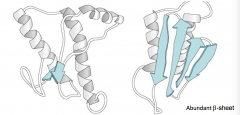
Diseased brain develops holes resulting in dementia- leading to death.
-Infectious agent is single protein, named PrP which is normal constituent in brain tissue found on surface of neurons. -illness occurs from abnormal PrP(sc from scrapie) -abnormal protein highly infective and not destroyed -Results from changing the a-helic to b-pleated sheet |

